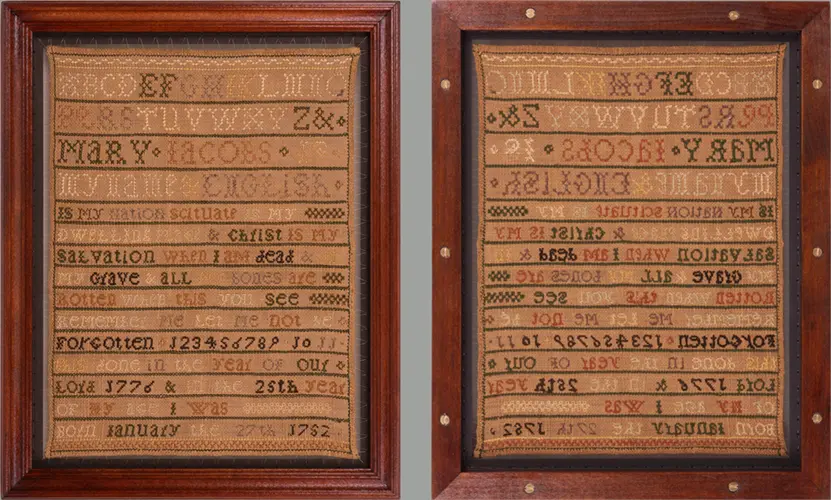Mary Jacobs
Scituate, Plymouth County,
Massachusetts, 1776

Samplers that are worked reversibly, with the back as beautifully finished as the front, are quite rare as accomplishing this requires great skill and discipline. We come across these very infrequently and have found that more were made in England than in America. The back of this sampler is so impeccably stitched we framed it so that both the front and back can be appreciated. It has been carefully stitched to a stretcher and spaced away from the glass on both sides.
This family history of samplemaker is very interesting. It reads, “Mary Jacobs is my name & English is my nation Scituate is my dwelling place & Christ is my salvation when I am dead & in my grave & all my bones are rotten when this you see remember me let me not be forgotten this done in the year of our Lord 1776 & in the 25th year of my age I was born January the 27th 1752.” Given her age and advanced skill in the needle arts, Mary might have been instructing younger girls when she made this sampler.
Mary was the daughter of Dr. Joseph and Mary (Foster) Jacobs and her baptism on May 10, 1752 was recorded at the Second Church of Scituate. The history of the Jacobs family in America is well documented in A Historical Sketch of the Town of Hanover, Mass., with Family Genealogies by John S. Barry (Boston, 1853). Dr. Joseph Jacobs was, “a skilful physician, a man of good talents, successful in his practice, and of respectable standing.”
The immigrant ancestor, Nicholas Jacobs, with his wife and two children, arrived in 1633, settling in Hanover and became active in the affairs of the town. His grandson, David Jacobs, removed to nearby Scituate circa 1688 and served as a deacon and schoolmaster.
At age 46 in 1798, Mary married John Foster (1740-1815), whose first wife was Mary’s older sister, Sarah Jacob (1741-1788). John was a soldier in the French & Indian War and later kept the family tavern at the Deacon Hatherly Foster House in Scituate, an important meeting place during the Revolutionary War. Mary died in 1819 and is buried in Second Parish Cemetery in Norwell, along with her husband and her sister.
The sampler was worked in silk on linen and is in excellent condition, framed with spacers and UV filter glass both front and back.

